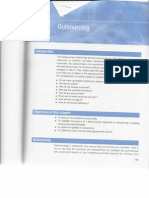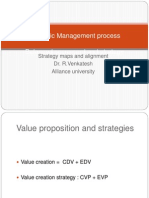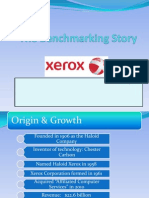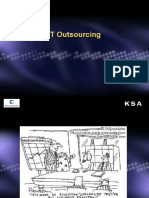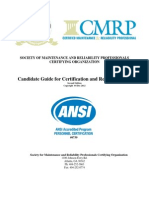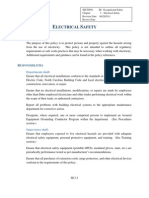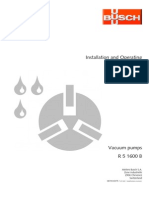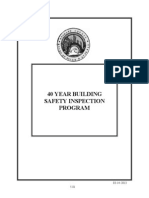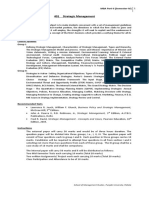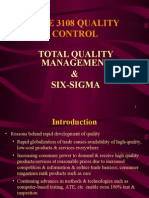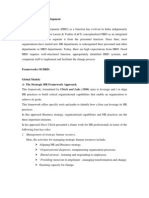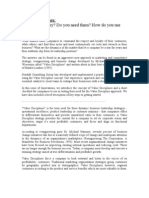16 OutsourcingFM
16 OutsourcingFM
Uploaded by
Ursula JohnsonCopyright:
Available Formats
16 OutsourcingFM
16 OutsourcingFM
Uploaded by
Ursula JohnsonOriginal Description:
Original Title
Copyright
Available Formats
Share this document
Did you find this document useful?
Is this content inappropriate?
Copyright:
Available Formats
16 OutsourcingFM
16 OutsourcingFM
Uploaded by
Ursula JohnsonCopyright:
Available Formats
Insourcing vs.
Outsourcing in Corporate Facilities Management
What is Outsourcing? Outsourcing is the strategic use of outside resources to perform activities traditionally handled by internal staff and resources. Outsourcing is a management strategy by which an organization outsources major, non-core functions to specialized, efficient service providers. Companies have always hired special contractors for particular types of work, or to level-off peaks and valleys in their workload. They have always partnered-formed long-term relationships with firms whose capabilities complement their own; companies have always contracted for shared access to resources that were beyond their individual reach-whether it be buildings, technology or people. But the difference with simply subcontracting and outsourcing is that outsourcing involves the wholesale restructuring of the corporation around core competencies and outside relationships. The following definitions have been furnished by the International Facility Management Association (IFMA): Insourcing: A common approach in which facility management executives look to outside facility management service firms as process experts. Outside service providers are hired as consultants to measure operations against the commercial benchmark and make recommendations for improvement. The internal staff then implements the recommendations. Outsourcing: Refers to a full transfer of the facility management functions to an outside firm. The corporation then manages the outsourcing contract rather than the entire facility management function. Out-Tasking: A word coined to further define the area to be tasked to an outsource provider. A new study, "Outlook on Outsourcing," shows outsourcing is a part of many companies strategic plans, indicated by more than 70 percent of the responses to a survey conducted by the International Facility Management Association (IFMA). According to the survey, the 10 services most often out-tasked are, in order: Architectural design, Trash and waste removal, Housekeeping, Facility systems, Landscape maintenance, Property appraisals, Major moves, Hazardous materials removal, Major redesigns Furniture moves. Out-taskingthe hiring of individual specialized vendorsappears to be used more frequently than outsourcing, which is the hiring of full-service, single-source vendors. The survey revealed all facility managers outsource services requiring specialty skills that are unavailable in-house or not cost-efficient to handle in-house. Furthermore, they outsource services so they can focus on their core competencies. Other reasons to outsource include acquiring access to specialty tools and equipment, adding flexibility for work fluctuations, enhancing quality and improving customer satisfaction. Respondents observed that outsourcing is good for some services, but not all. As a means of lowering overhead (via downsizing) and saving money, outsourcing will continue to be accepted, and is expected to increase in the next five years. The initiative to outsource generally originates in the facility management department. Most respondents said outsourcing has helped conserve their budgets and has been a key to improving performance quality. Thirty-three percent of facility managers who responded said they reserve the right to interview
and approve candidates for managerial, professional, non-managerial and technical positions. In outsourcing, new staff is often hired in lieu of retaining existing staff. However, 25 percent of facility managers say their companies use a combination of existing and new staff to handle outsourced services. Information Technology This is the fastest growing area for outsourcing today. Executives are currently outsourcing: Maintenance/repair Training Applications development Consulting and reengineering Mainframe data centers Client/server Networks Desktop systems End-user support Full I/T outsourcing
Executives are considering outsourcing:
Operations Administration Executives are currently outsourcing: Printing and reprographics Mailroom Consulting and training Records management Administrative information systems Supply/inventory Printing and reprographics
Executives are considering outsourcing:
Customer Service Executives are currently outsourcing: Field service Field service dispatch Telephone customer support Customer service information systems
Executives are considering outsourcing:
Field service dispatch Telephone customer support
Finance Executives are currently outsourcing: Payroll processing Purchasing Transaction processing General accounting Payroll processing Taxes
Executives are considering outsourcing:
Human Resources Executives are currently outsourcing: Relocation Workers' compensation Recruiting/staffing Consulting and training Human resource information systems
Executives are considering outsourcing:
Real Estate & Physical Plants Executives are currently outsourcing: Food and cafeteria services Facilities maintenance Security Facilities management Facilities maintenance Facilities information systems
Executives are considering outsourcing:
Sales and Marketing Executives are currently outsourcing: Direct mail Advertising Telemarketing
Executives are considering outsourcing:
Reservation and sales operations Field sales
Cost Still Primary Outsourcing Factor A survey conducted at the Outsourcing World Summit indicates that cost is still the main factor in outsourcing decisions. PricewaterhouseCoopers sponsored the survey, which was accomplished by polling summit attendees, who used hand-held keypads. Some of the questions and results were as follows: How much did spending on outsourcing change at your firm over the past year (1998)? 5% or less increase 32% 25% or more increase 19% Decrease 3% How satisfied are you with your outsourcing initiatives? Satisfied 49% Neither satisfied nor dissatisfied 21% Dissatisfied 17% Very satisfied 11% What is the single most important factor driving satisfaction? Realized cost benefits 42% Customer/end user satisfaction 24% Process improvement 20% Close working relationship 14% The main reason my company outsources is to Reduce costs 35% Focus on core competencies 30% What is the correlation between business process outsourcing and shareholder value in the mind of executives? Moderate 49% Strong 44% What is the financial analysis technique for making an outsourcing decision? Straight dollar decision 38% Cash flow 28% Efficiency measures (e.g., return on asset) 20% On a percent of contract basis, how much does your company spend managing an outsourcing relationship? Up to 5% 38% Up to 2% 37% Up to 10% 17% Based on a report from The Outsourcing Report Top 10 Reasons Companies Outsource 1. 2. 3. 4. 5. 6. 7. 8. Reduce and control operating costs Improve company focus Gain access to world-class capabilities Free internal resources for other purposes Resources are not available internally Accelerate reengineering benefits Function difficult to manage/out of control Make capital funds available
9. Share risks 10. Cash infusion Source: Survey of Current and Potential Outsourcing End-Users The Outsourcing Institute Membership, 1998 Top 10 Factors in Vendor Selection 1. 2. 3. 4. 5. 6. 7. 8. 9. 10. Commitment to quality Price References/reputation Flexible contract terms Scope of resources Additional value-added capability Cultural match Existing relationship Location Other
Top 10 Factors for Successful Outsourcing 1. Understanding company goals and objectives 2. A strategic vision and plan 3. Selecting the right vendor 4. Ongoing management of the relationships 5. A properly structured contract 6. Open communication with affected individual/groups 7. Senior executive support and involvement 8. Careful attention to personnel issues 9. Near term financial justification 10. Use of outside expertise Source: Survey of Current and Potential Outsourcing End-Users The Outsourcing Institute Membership, 1998 Top 10 Drivers Behind Today's Outsourcing Decisions (in alphabetical order) Accelerate reengineering benefits Access to world class capabilities Cash infusion Free resources for other purposes Function difficult to manage or out of control Improve company focus Make capital funds available Reduce operating costs Reduce risk Resources not available internally
Characteristics of a well-structured alliance Strategic synergy. Can the two (or more) organizations together achieve a high level of benefits? Growth opportunity. Can the relationship--and its benefits--be expanded? Less risk. Does the relationship reduce the level of risk for your organization? Excellent chemistry. Is there a good "fit" between your organization and the provider(s) organization? Clarity of purpose. Are the goals and benefits explicit and clear? Win-win. Does each party benefit fairly from the relationship?
Develop and document a preliminary Outsourcing Mission, Strategy and Goals (OMSAG) statement. An Outsourcing Mission, Strategy and Goals (OMSAG) statement is a document that sums up the organization's outsourcing intentions and the strategic rationale for outsourcing. The OMSAG statement should describe the: Processes to be outsourced and the broad objectives for outsourcing. Relationship of outsourcing to the overall corporate strategy. Links between the outsourced process and your company's core competencies. Strategic forces that are driving your organization into a relationship. Expected positioning of the relationship on the Strategic Sourcing Spectrum. Scope of coverage (international, across business lines and so forth). Critical risks involved. Expected duration of the relationship. The value proposition In drawing up a value proposition: Consider how specific target customers (internal or external) are affected - how the relationship's product or service makes the customer more: Successful? Profitable? Competitive? Efficient? Effective? Productive? Satisfied? Seek validation from target customers. Describe explicit, quantified benefits. Fix the date when measurable success is expected. Assess the feasibility of reaching goals. Consider the advantage of an alliance versus other approaches. Strive for simplicity and elegance. For example, a value proposition might state that "by FY2003, the sourcing alliance will reduce the cost of our travel by 35%, increase productivity of our personnel on travel assignments by 15%, and establish a performance-metrics system that allows us to measure both of these goals." The Performance Work Statement The PWS defines what is being requested, the performance standards and measures, and timeframes required. It provides the basis for the technical performance sections of the RFPs. It states the requirements in terms of "what" is to be the required output rather than "how" the work is to be performed. When developing the PWS, take special care to ensure that it does not limit service options, arbitrarily increase risk, reduce competition, unnecessarily violate industry service or service grouping norms, or omit statutory or regulatory requirements without full justification. The PWS should be performanceoriented, specifying what outputs or measures are desired and limiting directions as to how the results are achieved. INDUSTRY: In July, 1996, J.P. Morgan signed a contract with a prime contractor and 3 subcontractors to outsource approximately 30 percent of J. P. Morgans IT functions. The value was estimated at $2.1 billion over 7 years. The scope of the outsource activities included J. P Morgans IT infrastructure (mainframe data centers, midrange computing, client/server, desktops, voice and data networks), plus about 20 percent of their software application base. Approximately 900 employees were transferred from J.P. Morgan.
Benefits achieved: Costs in general have fallen and fixed costs have been reduced, Company managers are beginning to focus on strategy rather than on day-to-day operations, and The company has gained access to IT skills it could never have developed internally.
Keys to success: Teamwork and communication between all parties. Source - Integration Management, "Ten Deals That Shook the Globe," Mark Mehler, (http://www.integrationmanagement.com/sub_sections/ten_deals.html, January 29, 1998) FEDERAL: In August, 1977, the National Air and Space Administration (NASA) outsourced IT operations at its Jet Propulsion Laboratories (JPL) to a Prime contractor. The contract was estimated at over $200 Million over a 5 year time period. The contractor will provide personnel, computer hardware and software as well as equipment and support services for over 7,000 PCs. The fixed-price, performance-based contract covers help-desk services, systems administration, software acquisitions and upgrades, computer hardware maintenance, and hardware replenishment. Key Objective: Focus on core competencies. Source NASA Press Release c97-k, August 26, 1997 STATE & LOCAL: In 1996, the City of Indianapolis awarded a contract to a prime contractor to provide IT services to the City and the surrounding Marion County. The scope of the effort included all IT services not involved with Public Safety. The contract was estimated at $81 Million over 7 years. Key Objectives: Reduced costs Improved quality Access to better talent Enhanced public access to records.
INTERNATIONAL: In May 1994, Britains Inland Revenue (comparable to the Internal Revenue Service in the United States) signed an outsourcing contract with a prime contractor to provide computer services previously provided by Inland Revenues in-house Information Technology Office. The contract was a 10 year "strategic partnership" estimated at over $1.6 billion. Approximately 1,900 employees from Inland Revenue were transferred to the contractor. Key Objectives: Substantial improvements in cost-effectiveness Significantly improved speed of response in the development and enhancement of systems Rapid access to the latest information technology skills and technologies Optimized career opportunities for Information Technology Office staff.
Source National Audit Office, Report by the Comptroller and Auditor General, "Inland Revenue: Market Testing the Information Technology Office", March 8, 1995. Effectively Managing The Outsourcing Relationship Outsourcing is growing at a rapid rate in the United States, Europe and Asia because organizations view outsourcing as a way to achieve strategic goals, reduce costs, improve customer satisfaction and provide other efficiency and effectiveness improvements. Like any organizational decision, outsourcing requires effective management from the outset of the outsourcing evaluation through the life of the contractual relationship. Define the Objectives you Want to Achieve; Outsource for the Right Reasons; Answer Key Questions; Use a Methodical Approach; Planning Phase; Analysis Phase; Design Phase; Implementation Phase; Operations Phase; Termination Phase Consider All Stakeholders; Get the Right People Involved; Understand the Vendors; Realize that Outsourcing is not All or Nothing; Choose the Right Relationship; Negotiate a Sound Contract; Terms of the agreement; Minimum services levels; Ownership and confidentiality of data; Warranty; Exhibits; Incentives; Disclaimers; Bankruptcy; Force Majeure (Acts of God); Performance measures; Anticipating change. Use Performance Incentives and Penalties; Establish a Relationship Management Structure and Processes as Part of the Contract; Use Objective Performance Criteria; Emphasize the Development of the People Responsible for Relationship Management; Manage the People Issues.
You might also like
- Planning is a useless endeavor because developments in e-business and e-commerce and in the political, economic, and societal environments are moving too quickly nowadays.” Do you agree or disagree with this statement? Why?Document11 pagesPlanning is a useless endeavor because developments in e-business and e-commerce and in the political, economic, and societal environments are moving too quickly nowadays.” Do you agree or disagree with this statement? Why?riya7sen100% (8)
- The Outsourcing Revolution: Focus Take-AwaysDocument5 pagesThe Outsourcing Revolution: Focus Take-AwaysTkay C CappaNo ratings yet
- The Real-Time Contact Center: Strategies, Tactics, and Technologies for Building a Profitable Service and Sales OperationFrom EverandThe Real-Time Contact Center: Strategies, Tactics, and Technologies for Building a Profitable Service and Sales OperationNo ratings yet
- Audit ChecklistDocument3 pagesAudit Checklistlbss22008No ratings yet
- Rummler Performance ImprovementDocument21 pagesRummler Performance ImprovementEduardo José López100% (1)
- Building Competitive Advantage Through PeopleDocument41 pagesBuilding Competitive Advantage Through Peoplekritz570% (2)
- Preparing An Outsourcing Cost/Benefit AnalysisDocument7 pagesPreparing An Outsourcing Cost/Benefit AnalysissirishaakellaNo ratings yet
- Get The Greatest Value: Choosing Between Internal Shared Services and BPODocument4 pagesGet The Greatest Value: Choosing Between Internal Shared Services and BPOmgajen100% (1)
- Hackett HR Outsourcing Best Practices PDFDocument8 pagesHackett HR Outsourcing Best Practices PDFDipak ThakurNo ratings yet
- Initial Stages of EvolutionDocument5 pagesInitial Stages of EvolutionVivek MulchandaniNo ratings yet
- Outsourcing: The Good, The Bad & The UglyDocument31 pagesOutsourcing: The Good, The Bad & The Uglypremkumarn9734No ratings yet
- Do What You Do BestDocument10 pagesDo What You Do Bestpriyanka joshiNo ratings yet
- Outsourcing 2Document14 pagesOutsourcing 2Garang GeorgeNo ratings yet
- Business Process Out SourcingDocument33 pagesBusiness Process Out SourcingRupalee GuptaNo ratings yet
- ProjectmgmtDocument2 pagesProjectmgmtPankaj DhanoreNo ratings yet
- Global OutsourcingDocument39 pagesGlobal OutsourcingKaran GuptaNo ratings yet
- Basic Procu.t Ch-2Document21 pagesBasic Procu.t Ch-2feyisaabera19No ratings yet
- BPO Preparation For ExamDocument12 pagesBPO Preparation For Examyashvirbudhwar5No ratings yet
- Balanced Score Card and StrategyDocument20 pagesBalanced Score Card and StrategyMohammed FaisalNo ratings yet
- Supply Chain Management:: From Vision To ImplementationDocument38 pagesSupply Chain Management:: From Vision To ImplementationFaribaTabassumNo ratings yet
- Org Design PerspectiveDocument11 pagesOrg Design Perspectivevikas.manhasNo ratings yet
- Project Management and Organisational StrategyDocument12 pagesProject Management and Organisational StrategyfgdgdfgdfgNo ratings yet
- I. Balanced Scorecard BasicsDocument25 pagesI. Balanced Scorecard BasicsSanjita TanDonNo ratings yet
- OutsourcingDocument32 pagesOutsourcingMinu HarlalkaNo ratings yet
- DocumentDocument5 pagesDocumentLeratoNo ratings yet
- The Trend of Bringing Your Outsourced IT Deal Back In-House - 030113us - SDTDocument12 pagesThe Trend of Bringing Your Outsourced IT Deal Back In-House - 030113us - SDTabobedro90No ratings yet
- Partnership and ResourcesDocument9 pagesPartnership and ResourcesDunia MiqdadNo ratings yet
- Creating A Lean Finance OrganizationDocument2 pagesCreating A Lean Finance OrganizationStephen G. LynchNo ratings yet
- Recruitment SourcesDocument7 pagesRecruitment SourcesPuneet Jindal0% (1)
- Principles of Total Quality: Assignment No# 01Document5 pagesPrinciples of Total Quality: Assignment No# 01imranghouri100% (1)
- Structured Approach To Implementing and Operating Outsourcing and Managed Services For Suppliers and Outsourcing OrganisationsDocument340 pagesStructured Approach To Implementing and Operating Outsourcing and Managed Services For Suppliers and Outsourcing OrganisationsAlan McSweeney100% (1)
- PWC Performance Survey 2015Document28 pagesPWC Performance Survey 2015Khushbu SinghNo ratings yet
- Cost Benefits and Critical Success FactorsDocument3 pagesCost Benefits and Critical Success FactorsHamza HasnyneNo ratings yet
- HR OutsourcingDocument22 pagesHR OutsourcingRagini Johari50% (4)
- Module 1 - Introduction To The Information Technology and Business Process Management (IT-BPM) IndustryDocument7 pagesModule 1 - Introduction To The Information Technology and Business Process Management (IT-BPM) IndustrydrinkingpinoyNo ratings yet
- Shared Service MethodologyDocument12 pagesShared Service MethodologyAnoo VanamNo ratings yet
- OutsourcingDocument105 pagesOutsourcingSneha Dubey100% (1)
- Aarti BhajanDocument86 pagesAarti Bhajanचेतांश सिंह कुशवाहNo ratings yet
- Benchmarking: Presentation byDocument19 pagesBenchmarking: Presentation byVicky Vignesh Thanga PandiNo ratings yet
- Presentation1 Compatibility ModeDocument12 pagesPresentation1 Compatibility ModebdiitNo ratings yet
- Operational ManagementDocument22 pagesOperational ManagementTanuj SharmaNo ratings yet
- Framework For Shared ServicesDocument10 pagesFramework For Shared Servicesreyad100% (1)
- Xerox PPTDocument26 pagesXerox PPTDipti KumarNo ratings yet
- Benchmarking - Note 1Document18 pagesBenchmarking - Note 1Rameswar NayakNo ratings yet
- Week-5 Chapter-4 Assignment-Out SourcingDocument6 pagesWeek-5 Chapter-4 Assignment-Out SourcinglikhithabhuvanaNo ratings yet
- HRM Process of BestBuy & AccentureDocument20 pagesHRM Process of BestBuy & AccentureWasimAkramNo ratings yet
- Manta Group BrochureDocument3 pagesManta Group Brochureeyoung9No ratings yet
- Inside: Key Drivers For Competitive AdvantageDocument6 pagesInside: Key Drivers For Competitive AdvantagesambitpandaNo ratings yet
- 1:1 ABSTRACT: The Continuous Pursuit of Excellence Is The Underlying and EverDocument29 pages1:1 ABSTRACT: The Continuous Pursuit of Excellence Is The Underlying and EveryudhistharNo ratings yet
- Service Operations 2017 2018Document23 pagesService Operations 2017 2018Vijay Singh ThakurNo ratings yet
- Industry ProfileDocument5 pagesIndustry ProfileS.Abyisheik ReddyNo ratings yet
- Bench MarkingDocument70 pagesBench MarkingCarlos FernandezNo ratings yet
- ERP Implementation in Agribusiness - A Case of Mumias Sugar Company Betty OlwenyDocument16 pagesERP Implementation in Agribusiness - A Case of Mumias Sugar Company Betty Olwenys0517No ratings yet
- The Outsourcing Vendor Management Program Office (VMPO) : Art, Science, and The Power of PerseveranceDocument36 pagesThe Outsourcing Vendor Management Program Office (VMPO) : Art, Science, and The Power of Perseverancevir_4uNo ratings yet
- Operational Excellence PerformanceDocument8 pagesOperational Excellence PerformancePrathap SankarNo ratings yet
- It OutsourcingDocument19 pagesIt OutsourcingTamizhvananRamamurthy100% (1)
- Faculty of Civil Engineering: Sample of Good AssignmentDocument19 pagesFaculty of Civil Engineering: Sample of Good AssignmentJules MoujingNo ratings yet
- Research Study (42662) Madan Lal GaireDocument2 pagesResearch Study (42662) Madan Lal Gairemadan GaireNo ratings yet
- The Outsourcing Revolution (Review and Analysis of Corbett's Book)From EverandThe Outsourcing Revolution (Review and Analysis of Corbett's Book)No ratings yet
- Business Process Mapping: How to improve customer experience and increase profitability in a post-COVID worldFrom EverandBusiness Process Mapping: How to improve customer experience and increase profitability in a post-COVID worldNo ratings yet
- IT GOVERNANCE APPROACHES FOR AGILE SOFTWARE DEVELOPMENT INVESTMENTSFrom EverandIT GOVERNANCE APPROACHES FOR AGILE SOFTWARE DEVELOPMENT INVESTMENTSRating: 4 out of 5 stars4/5 (1)
- Variable Frequency Drives (Primary+Condense Pump)Document90 pagesVariable Frequency Drives (Primary+Condense Pump)Trần Khắc ĐộNo ratings yet
- Calendar TemplateDocument1 pageCalendar TemplateUrsula JohnsonNo ratings yet
- FHcom Kaizen FormsDocument14 pagesFHcom Kaizen FormsUrsula JohnsonNo ratings yet
- Individual - Application - Rate IncreaseDocument2 pagesIndividual - Application - Rate IncreaseUrsula JohnsonNo ratings yet
- Review On Job DescriptionDocument1 pageReview On Job DescriptionUrsula JohnsonNo ratings yet
- IA Report Maintanence WorksDocument19 pagesIA Report Maintanence WorkshossainmzNo ratings yet
- Part D Knut BogeDocument14 pagesPart D Knut BogeUrsula JohnsonNo ratings yet
- Procedures and Guidelines For Thermal Imaging: Research Product 88-39Document27 pagesProcedures and Guidelines For Thermal Imaging: Research Product 88-39Ursula JohnsonNo ratings yet
- Landlords Guide To Electrical Safety in ScotlandDocument44 pagesLandlords Guide To Electrical Safety in ScotlandUrsula JohnsonNo ratings yet
- SMRPCO Candidate Guide For Certification Recertification - 5!9!13Document40 pagesSMRPCO Candidate Guide For Certification Recertification - 5!9!13Ursula JohnsonNo ratings yet
- Predictive Maintenance in A Mission Critical EnvironmentDocument9 pagesPredictive Maintenance in A Mission Critical EnvironmentUrsula JohnsonNo ratings yet
- Electrical Safety Inspection 1210Document4 pagesElectrical Safety Inspection 1210Ursula JohnsonNo ratings yet
- POLA Electrical Safety Audit Final 1-10-13 PDFDocument248 pagesPOLA Electrical Safety Audit Final 1-10-13 PDFUrsula JohnsonNo ratings yet
- Electrical SafetyDocument10 pagesElectrical SafetyUrsula JohnsonNo ratings yet
- Periodic Inspection Reporting - : Recommendation Codes For Domestic and Similar Electrical InstallationsDocument20 pagesPeriodic Inspection Reporting - : Recommendation Codes For Domestic and Similar Electrical InstallationsUrsula JohnsonNo ratings yet
- Electrical Safety Assessment Document Final3Document134 pagesElectrical Safety Assessment Document Final3Ursula Johnson100% (1)
- Wärtsilä Electrical Audits: The Complete Electrical Health Check Tailored To Your InstallationDocument4 pagesWärtsilä Electrical Audits: The Complete Electrical Health Check Tailored To Your InstallationUrsula JohnsonNo ratings yet
- O&M Manuals - Process Vacuum PumpsDocument28 pagesO&M Manuals - Process Vacuum PumpsUrsula JohnsonNo ratings yet
- More Detailed Electrical Inspection Report: Cover PageDocument33 pagesMore Detailed Electrical Inspection Report: Cover PageUrsula JohnsonNo ratings yet
- More Detailed Electrical Inspection Report: Cover PageDocument33 pagesMore Detailed Electrical Inspection Report: Cover PageUrsula JohnsonNo ratings yet
- BLDG Safe Insp2009Document18 pagesBLDG Safe Insp2009Ursula JohnsonNo ratings yet
- Internal MarketingDocument9 pagesInternal MarketingMd Hassan100% (1)
- Sikkim Manipal University: "A Study On The Critical Suceess Factors of Erp Life Cycle Implementation at Gorana Group"Document18 pagesSikkim Manipal University: "A Study On The Critical Suceess Factors of Erp Life Cycle Implementation at Gorana Group"AnjaliNo ratings yet
- Consulting Prep Book-KelloggDocument21 pagesConsulting Prep Book-KelloggManish SharmaNo ratings yet
- SC8F1Document21 pagesSC8F1Saori NagaseNo ratings yet
- CSC - The Emergence of Business Process ManagementDocument90 pagesCSC - The Emergence of Business Process ManagementCaroline ScharlauNo ratings yet
- Assignment MIS 2Document5 pagesAssignment MIS 2Madhu M NairNo ratings yet
- 15 Activity Based Management and Costing IM May 2014Document10 pages15 Activity Based Management and Costing IM May 2014erjan nina bombayNo ratings yet
- BenchmarkingDocument15 pagesBenchmarkingPooja SheoranNo ratings yet
- BBA MIS PPT-2 Management Information System and Management ProcessesDocument67 pagesBBA MIS PPT-2 Management Information System and Management Processeskrishna rakholiya100% (1)
- Software-Re Engineering NetDocument37 pagesSoftware-Re Engineering Nethrashid298No ratings yet
- The Process Focused Organization PDFDocument240 pagesThe Process Focused Organization PDFGermán Cárdenas AlvarezNo ratings yet
- 401 Strategic Management: MBA Part-II (Semester-IV)Document39 pages401 Strategic Management: MBA Part-II (Semester-IV)GangadharNo ratings yet
- Chap 009Document21 pagesChap 009Alif Nur FirdausNo ratings yet
- Seth Godin - Linchpin - Are You Indispensable - (2010)Document274 pagesSeth Godin - Linchpin - Are You Indispensable - (2010)Ajay Shahi100% (1)
- Strategic LeadershipDocument8 pagesStrategic LeadershipMazlina MazlanNo ratings yet
- Suskin & Hall: Responding To The Crisis-Reengineering Court Governance and StructureDocument35 pagesSuskin & Hall: Responding To The Crisis-Reengineering Court Governance and StructureNew England Law ReviewNo ratings yet
- Chapter 7Document43 pagesChapter 7Yun LeeNo ratings yet
- TQM and Six SigmaDocument38 pagesTQM and Six SigmaNik SyarihanNo ratings yet
- Providian Trust DPDNDocument17 pagesProvidian Trust DPDNNgu KhaNo ratings yet
- HRD AssignmentDocument17 pagesHRD AssignmentKarpagam Chandrasekaran67% (3)
- DSM Placement Summer Internship BrochureDocument56 pagesDSM Placement Summer Internship Brochureanon_902581471No ratings yet
- Chapter 4: Trends in Information Systems Development: System TheoryDocument19 pagesChapter 4: Trends in Information Systems Development: System TheoryMina twiceNo ratings yet
- BookofProceedings ICOPEV2014Document314 pagesBookofProceedings ICOPEV2014Jeronimo SantosNo ratings yet
- ERPDocument51 pagesERPsajjadmubinNo ratings yet
- Indirect Source To Pay OverviewDocument4 pagesIndirect Source To Pay OverviewLionelkeneth12No ratings yet
- Unit 13Document17 pagesUnit 13Shobhit SaxenaNo ratings yet
- Value DisciplinesDocument6 pagesValue Disciplinesyouth_kid029No ratings yet













